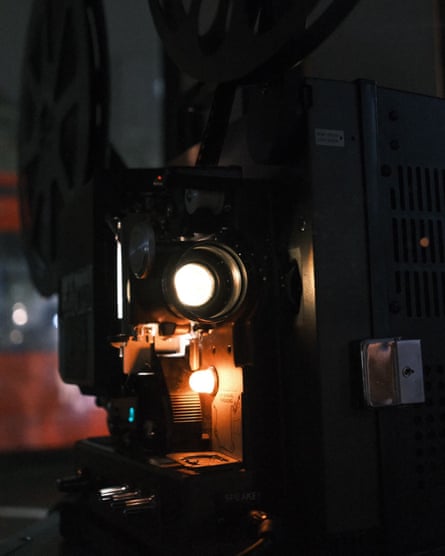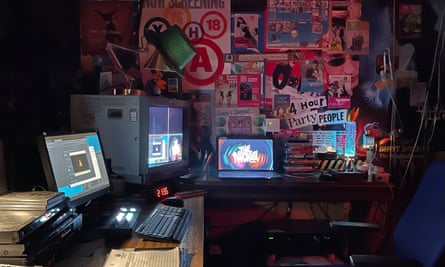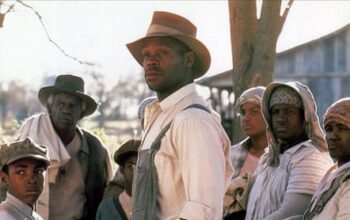As staff read out fire safety precautions and evacuation procedures before a 35mm nitrate print screening of Black Narcissus at the BFI, the packed crowd titter in excitement and anticipation. How often do you go to the cinema with an awareness that the film you are watching is being physically unspooled, live, with a possibility of actual combustion due to the ultra-flammable material it contains?
The desire to watch films projected on film is on the rise across the UK – and the number of repertory film clubs dedicated to analogue screenings is ballooning. Sheffield-based Reel Steel seek out rare gems – “doing the detective work to find 35mm prints in a screen-worthy condition can be a year-round task”, says founder Joseph Harris. Manchester-based Certificate X Cult Film Screenings and Bristol’s Hellfire Video Club show B-movie or cult fare. In London’s Elephant and Castle, the Nickel is about to open as a “grindhouse” cinema, purveyors of “the most subversive, bewildering, sensational, fearless, sublime, shocking, transgressive, death-defying, psychedelic, psychotronic, bizarre, rebellious, baffling, degenerate cinematic treasures”.
It is noteworthy that many of these organisations, including Liverpool’s Paraphysis Cinema, and London’s Category H and Movies Are Dead, were all created less than a year ago. What are they providing that the regular cinema experience can’t match? “The differentiation is in content and presentation,” says Geoffrey Badger, founder of the independent film programming organisation Lost Reels. He sees their screenings as a form of cinematic resuscitation. “To highlight forgotten or neglected films that are off-the-radar for one reason or another and try to keep them alive.” When it comes to the format, Badger almost always shows film prints – 16mm or 35mm – and frequently adds context with written essays, interviews and Q&As, these cultural add-ons being a huge draw for film fans.

“I’ve worked as a film-maker my whole life, but the idea of preserving and presenting underseen cinematic gems suddenly seemed just as important to me as making new stuff,” says Dominic Hicks, founder of the Nickel. It began life as a repertory film club hosting pop-up events and now aims to embody the do-it-yourself anarchy of the films it wants to spotlight. The Scala in London, the erstwhile King’s Cross cinema known for its eclectic and controversial screenings, “is a big influence on what I’m trying to do”, Hicks says.
The Badlands Collective, a London-based group similarly dedicated to hosting special events of under-screened movies, was inspired into existence after seeing it happen in New York. “It’s about filling a gap,” says co-founder Ian Mantgani. “Every independent programmer will have different ideas on what gaps need filling, which is what makes the scene idiosyncratic and lively.” Each group, though, seems to share an ethos: “Showing things we love, almost always on 35mm prints, that somehow aren’t being screened in repertory theatrical rotation or have fallen out of circulation entirely.”
That’s not to suggest that film clubs are a new phenomenon. Idiosyncratic screening nights have been around for years, and since 2011 have been channelled across the UK through the Scalarama festival. But with a new appreciation of the limitations of streaming services – both overwhelming and restrictive – there’s been a marked uptick in the activity of these organisations around the country, particularly those with a focus on genre cinema or with a specific niche.
For Hicks, the film-on-film revival is akin to the vinyl resurgence of the past decade, and deserving of the same accelerated growth – vinyl sales were, in 2023, at their highest level this century. For many analogue lovers, the sound of the needle lowering on to a disc, or the gentle rustle of the LP’s sleeve, adds to the experience. The whir of a film projector or the crackle of an unspooled film print is no different. “I’ve always collected vinyl, so this was just a natural progression to a harder drug for me,” Hicks says. Like vinyl, “these prints each have their own stories. They would go on the road, from one screen to the next. Some were rescued from attics or abandoned neighbourhood cinemas or TV stations. They carry their histories with them. And they’re fragile, rotting, fading, they’re precious. There’s something beautiful in their fragility.”
Finding a reliable space for these screenings, however, is one of the main challenges for repertory film clubs. Hicks has found a permanent home for the Nickel, but “it has no water or power at the moment”, so he has started a crowdfunding campaign. “There are so many amazing film clubs, from Token Homo to Ciné-Real,” says Hicks, “but often we have to beg or borrow for screening spaces. Pub function rooms or bars.” Independent cinemas such as the Chapter Arts Centre in Cardiff or the Queen’s Film Theatre in Belfast, and places such as the Cinema Museum – itself not safe from closure, having campaigned their own survival in 2017 and still crowdfunding to own their premises – provide lifelines for repertory film clubs. “But these communities deserve a permanent home,” says Hicks.

Working with rare films and dusty prints brings unique challenges. “The process of finding them reveals exactly why they’re out of circulation – difficult or expensive rights, no available prints, or other issues such as a distributor with no interest in the film,” says Badger. “For one of my events, David Lynch had to personally approve the screening and the only surviving print I could find had to be imported from Spain.” Mantgani agrees. “The big challenge is usually finding that a print of something we want to show is overseas. If the BFI or some other body had a print importation fund for independent groups like us, it would open up a world of possibilities.”
For those lucky enough to have a home, the success of repertory cinema screened on film is already evident. In 2023, the BFI hosted its inaugural Film on Film festival, with heaving screenings proving that interest in this medium is at a real turning point. “Clearly audiences embrace the opportunity to experience the aesthetic and emotional differences between physical film and digital projection,” says programme director Robin Baker. While BFI Southbank has screened on celluloid as part of its regular programming for decades and showing film-on-film is not ancient history for many of its regular patrons, “8,000 people attended over the three days,” he says, and “40% of the audience was 34 or under – a clear indication of the appetite of younger audiences to watch films projected on film.”
Even these larger organisations face challenges, though. Perhaps nothing proves how difficult these endeavours can be than when the festival’s opening night film, a nitrate print of Mildred Pierce, had to be rescheduled at the last minute due to technical issues. Other general challenges with the film on film format, Baker says, are based around reel preservation, equipment and high transport costs. “Even if a venue can afford to purchase 35mm projectors,” Baker says, “do they have the space in a 21st-century projection box to accommodate it?”
A shared ethos between behemoths such as the BFI and rough-hewn community groups prevails though: streaming platforms “give us the illusion of choice” says Hicks, but “are no substitute for a lovingly curated space for cinephiles.” Resuscitating interest in film from the past, screened on the medium they were made for, is the ultimate goal. “To expose people to things outside their comfort zone,” says Hicks. “To contradict their algorithm.”
Source: theguardian.com


